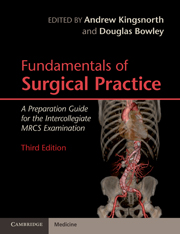Book contents
- Frontmatter
- Contents
- List of contributors
- Preface
- Section 1 Basic Sciences Relevant to Surgical Practice
- Section 2 Basic Surgical Skills
- Section 3 The Assessment and Management of the Surgical Patient
- 8 Preoperative assessment
- 9 Fundamentals of anaesthesia
- 10 Fundamentals of cancer management
- Section 4 Perioperative Care of the Surgical Patient
- Section 5 Common Surgical Conditions
- Index
- References
8 - Preoperative assessment
Published online by Cambridge University Press: 03 May 2011
- Frontmatter
- Contents
- List of contributors
- Preface
- Section 1 Basic Sciences Relevant to Surgical Practice
- Section 2 Basic Surgical Skills
- Section 3 The Assessment and Management of the Surgical Patient
- 8 Preoperative assessment
- 9 Fundamentals of anaesthesia
- 10 Fundamentals of cancer management
- Section 4 Perioperative Care of the Surgical Patient
- Section 5 Common Surgical Conditions
- Index
- References
Summary
The preoperative assessment (POA) of a patient presenting for surgery is a crucial component of management and embraces medical, surgical and anaesthetic care. The preoperative assessment should contribute to the patient's management and in particular to the decision-making process. For high-risk patients a multidisciplinary decision regarding the risk–benefit of the proposed surgery should be encouraged. An accurate preoperative assessment should allow the team to:
determine the need for surgery based on the patient's general status (should we operate; what should be performed; when should it be done?)
identify and optimize co-existing disease
select the best anaesthetic technique and perioperative management.
Assessment should be directed towards the individual patient and may be divided into: history, physical examination and investigations.
History
The best source of information relevant to any subsequent anaesthesia is obtained from a thorough history. A questionnaire can be given to the patient prior to clerking as a starting point, followed by more direct interrogation on receiving positive responses.
History of previous anaesthesia
The presence of co-existing disease and certain conditions are particularly relevant to anaesthesia. Warning notices following adverse reactions or complications during anaesthesia may be visible on patient records. Previous anaesthetic records should be examined for more detailed explanations.
- Type
- Chapter
- Information
- Fundamentals of Surgical PracticeA Preparation Guide for the Intercollegiate MRCS Examination, pp. 127 - 133Publisher: Cambridge University PressPrint publication year: 2011

